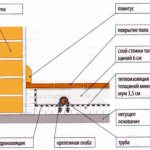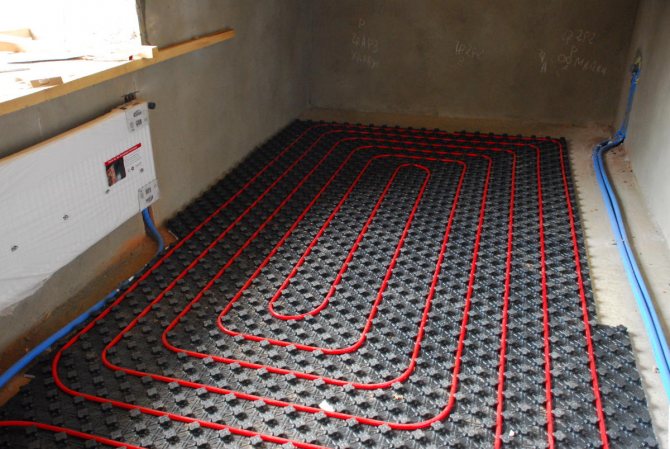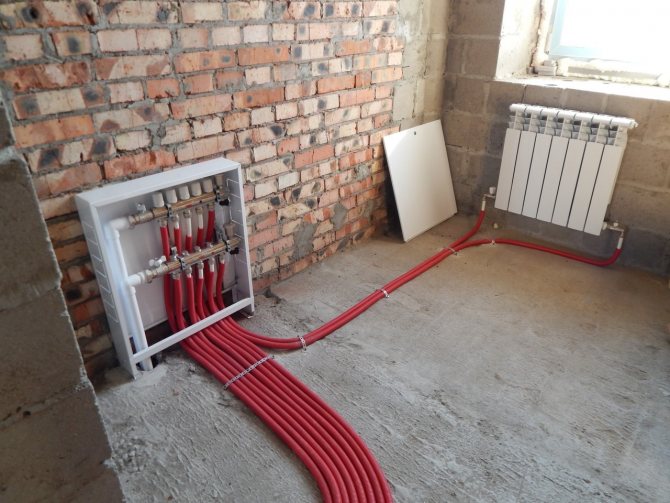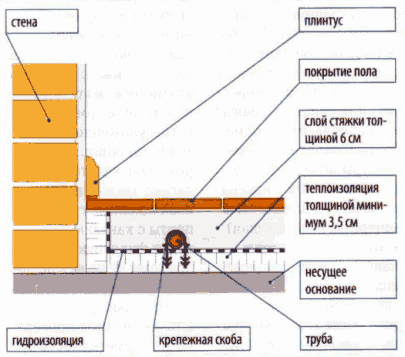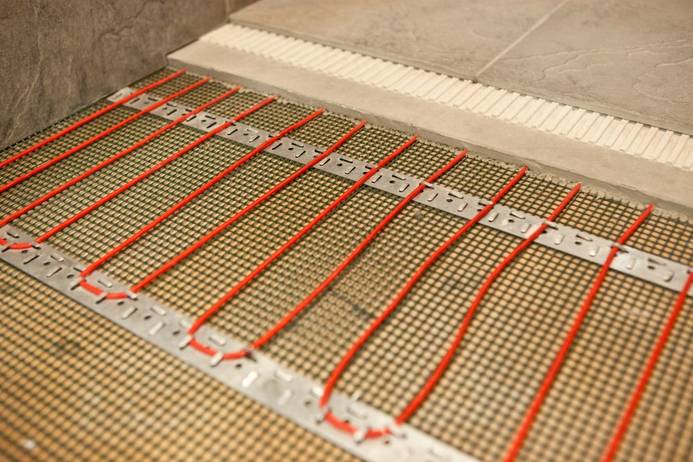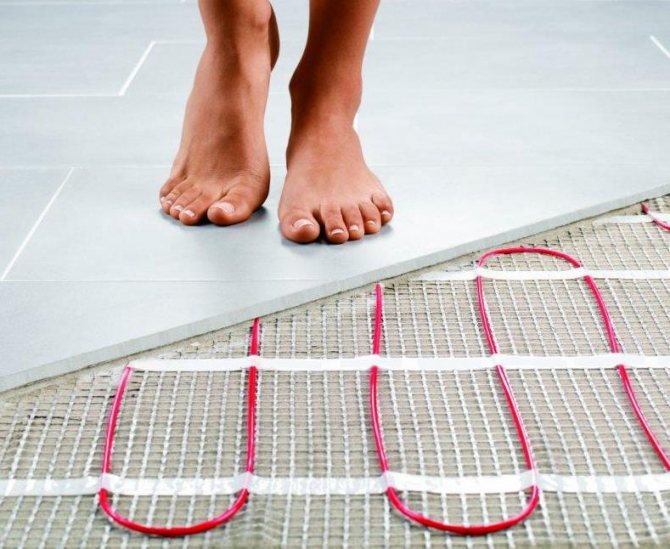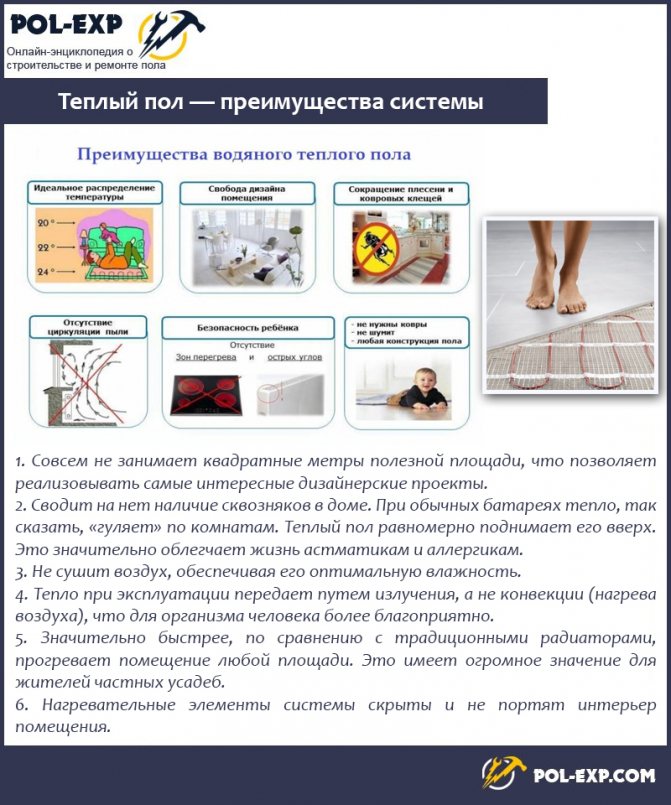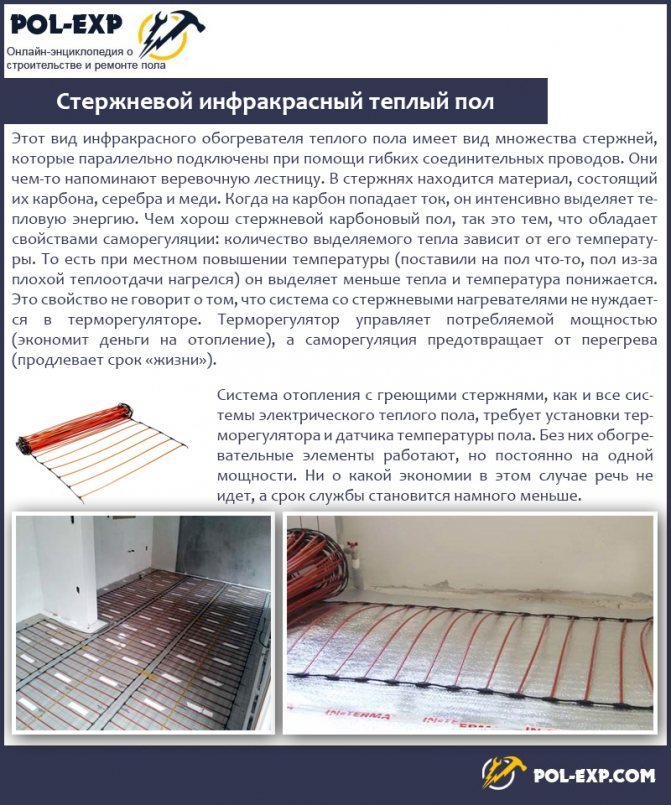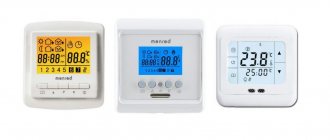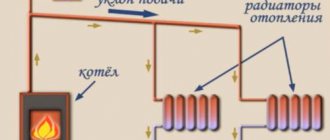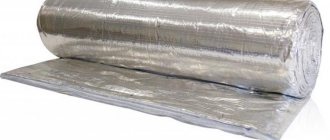Warm floor in a private house
Maximum underfloor heating temperature
|
| Warm water floor in a private house. The thickness of the vertical insulation between the wall and the screed must be the same as the horizontal one. |
The maximum floor surface temperature is limited to 29 ° C. Higher temperatures are unhealthy. It is recommended that in the area of permanent residence of people the floor temperature does not exceed 26 ° C. Along the outer walls and next to the windows, the floor can be heated up to 33 ° C to compensate for the increased heat loss in these areas.
The same floor temperature can be maintained in a bathroom, where people stay for a short time, and often without shoes. Due to the limitation of the floor surface temperature, the maximum power density of the underfloor heating system is 80 W / m2.
Maximum power of underfloor heating in a private house
A power of 80 W / m2 may not be enough for rooms with high heat losses, for example, with very large windows.
Problems can also arise in a small room, for example, in a cramped bathroom, in which, after installing a bath or shower, and other sanitary appliances, only a small area of the floor remains where you can lay the underfloor heating system.
The same can be true in small bedrooms, where a large bed and wardrobes cover a significant part of the floor, thereby reducing the efficiency of the underfloor heating system.
For example, a warm floor with an area of 10 m2 can deliver a power of 800 watts. The same power is provided by a panel radiator measuring only 50 x 50 x 15 cm due to the fact that its temperature is significantly higher than the temperature of the floor (in practice, 70-80 ° C).
For each room of a private house, you can choose a radiator of the required power, but it is not always possible to heat any room in the house with a warm floor.
The strength of the floors of a private house
The use of underfloor heating systems can be limited due to the additional load on the floor, since the pipes of the system must be laid in a fairly thick layer of heavy concrete screed.
When deciding to install a warm floor in a private house, you need to make sure that the load on the floor from the weight of the screed will not be excessive.
Please note that the thickness of the underfloor heating can significantly reduce the height of the room.
Warm floor will provide comfort and health.
The temperature distribution along the height, which is closest to ideal, is provided by the underfloor heating system, Fig. 1.
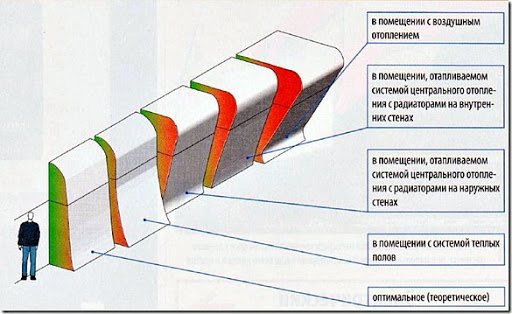

Thermal comfort conditions
- that is, such a state in which we are neither cold nor hot - are observed if the temperature of the heating surface does not exceed the temperature of our skin too much, and the air temperature does not differ much from the average temperature of the surfaces around us - walls, floor and ceiling.
This is only possible when using low-temperature underfloor heating, in this case underfloor heating. Moreover, the floor has a very large effect on the feeling of thermal comfort,
because this is the only enclosing surface with which we directly contact - through the feet of the feet, which are very sensitive to temperature.
It is especially desirable to use an underfloor heating system if a material with a high coefficient of thermal conductivity will be used as the flooring, such as stone or tiles, which seem cold to the touch.
Hyp allergenic floor heating
An important advantage of the underfloor heating system is no dust burning phenomenon,
due to the lower temperature of the heating surface. At temperatures above 55 ° C (the surface of the radiator usually has a higher temperature), the process of dry distillation of organic dust particles begins, which, rising up together with warm air, irritate the mucous membranes of the respiratory tract, causing a sensation of dryness in the throat.
Allergic reactions to dust depend not so much on the number of inhaled particles, but on their type - when heated to a temperature of more than 55 ° C, they increase in volume and irritate the mucous membranes even more. Therefore, low-temperature heating, which is a warm floor, in contrast to traditional radiator heating practically does not cause allergic reactions.
Do you need a warm floor in a private house - a source of comfort and health? The answer, I think, is obvious.
Heat to heat loss ratio
How much heat should a warm floor provide to heat a house? It depends on the heat loss at home. And they are always there, there is no zero heat loss. Heat goes into window and door structures, and through walls, and into the ceiling.
The amount of heat from the warm floor must be greater than or equal to the heat loss.


The surface temperature of the underfloor heating should not exceed certain values. We have collected them in a table with an indication of the regulatory document.
Maximum permissible temperature
Appointment
Document
For the premises of the constant stay of people.
SP 60.13330.20212, p. 6.5.12.
For rooms with temporary stay of people and swimming pool bypass paths
SP 60.13330.20212, p. 6.5.12.
floor surface temperature along the axis of the heating element in childcare facilities, residential buildings and swimming pools
SP 60.13330.20212, p. 6.5.12.
No more than 10 degrees
temperature difference in certain areas of the floor
Floor surface temperature
According to the international standard ISO 7730
In practice, the surface of a warm floor is heated up to 29 degrees in rooms with temporary stay of people, in bathrooms, etc.
Many people face this problem, including the user FORUMHOUSE with the nickname Shurigin.
The practical use of the warm floor was not entirely comfortable. There is a feeling of swelling in the legs. In the bathroom, wherever it went, you spend the least time there, but in the kitchen this feeling is noticeably intensified.
Much also depends on what material the flooring is made of. Calculations were made for completely identical rooms, but with different types of flooring. The types of coatings are listed in ascending order of the required temperature of the underfloor heating surface for heating the room:
- parquet
- ceramic tile
- linoleum
- laminate
Underfloor heating in a private house saves heat energy
The comfortable temperature in a room with underfloor heating is 2 ° C lower than with radiator heating.
This reduction in temperature can save up to 5% of heat energy for heating. This is due to the phenomenon of heat radiation by our body in the direction of cold surfaces - in this case, the floor.
If the floor is warmer, in its direction less heat is radiated from our body,
therefore, the required comfortable thermal balance is achieved at a lower room temperature. This is the most important advantage of radiant heating.
The possibility of a slight decrease in the room temperature without loss of comfort is also affected by temperature distribution over height.
If your feet are warm, the room temperature may be slightly lower without discomfort.
Summarizing
Whether the warm floor will cope with heating or not, directly depends on the insulation of the house. If the heat loss is low, then yes, it will cope. If they are large, a combined heating system is needed.In disputable cases, additional calculations and checks are needed: heat loss should not exceed the heat flux from the warm floor.
You can focus on this table:
Heat loss of the building W / m
Recommendations
Underfloor heating most likely will not cope with the function of a single heating system, you will need a combined CO
In this case, calculation and verification of power is necessary.
With a high probability, underfloor heating will cope with heating the house.
On FORUMHOUSE you can find any information on different types of floor heating systems, read an article about the features of a floor heating system using metal heat distribution plates, see a photo report, which tells about the features of installing a warm floor using metal plates and aluminum foil and watch the video “Heating without gas: engineering communications with your own hands. "
The question is often asked whether it is possible to heat a house with one warm floor. And, as is usually the case, there is no definite answer to this question. Why? Because it is impossible to pose the question in this way. Or, more precisely, it is impossible to give a correct answer to a question posed in this way.
Without information about: in which region you want to have such a heating source, how your house is insulated, what is the glazing area, what are the dimensions of the premises, finally, what is the meaning of the concept of "warm floor", what do you want to get from this heat source ... After all, underfloor heating is most often not a way to heat a house, but a source of increased comfort in the house.
Warm floor is a heat accumulator.
A warm floor heats up several times longer than radiators - before the heat begins to be transferred into the room, the concrete slab must heat up, in which the pipes with the coolant are placed. The heated concrete slab will give off heat after a long time
after shutting off the flow of coolant into the system.
The ability of a warm floor to be a heat accumulator, to slow down the processes of temperature changes in the room, optimizes and stabilizes the operating mode of a heating boiler, especially a solid fuel one. More about this read here.
At the same time, underfloor heating is more difficult to adapt to rapidly changing heat demand with a sharp change in outdoor temperature. This can lead to overheating of the premises, that is, to unnecessary heat loss. Or vice versa, to underheating and a decrease in thermal comfort. High thermal inertia
also makes it difficult to periodically drop the temperature during the absence of residents.
House insulation
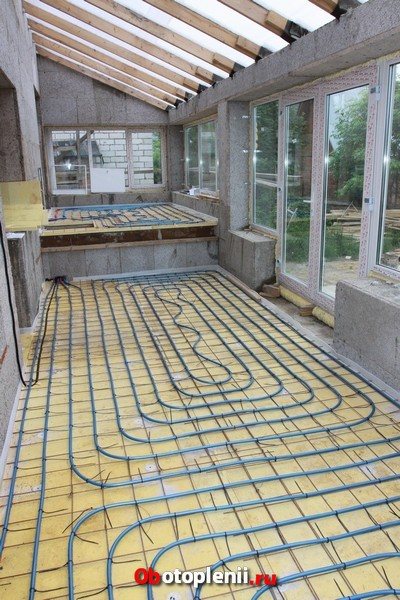

Is it necessary to insulate the house in a special way to use a heating system without radiators? The question is strange and incomprehensible. If you are building a house of permanent residence and in your region there are cold winters, and you do not want to heat the street, then the house needs to be well insulated in any case. Warm floors have nothing to do with it.
It is important to pay attention to:
- Tightness of window and door blocks;
- High-quality finishing of external walls for moisture protection of the house;
- Integrity and insulation of the roof;
- Not high-quality gutters at home;
- Poorly made thermal insulation of communications around the house, in the attic, in the basement;
- Basement temperature and humidity conditions.
Automatic control of underfloor heating in a private house
Automatic control of the heating system is necessary to maintain a comfortable temperature in the premises, as well as to optimize energy consumption.
The lack of regulation can lead to overheating of the premises and increased heat consumption.
The figure below shows control circuit diagram
a mixed heating system of a private house - using underfloor heating and radiators.


To control the radiator system, the automation is sufficient, which is equipped with the boiler, supplemented by thermostatic valves installed on the radiators.Connecting the underfloor heating circuit to the heating system requires the use of additional devices that reduce the temperature of the coolant entering the system - mixing pump and three-way mixing valve.
Warm floors with a weather regulator
Considering that the underfloor heating system has a high inertia (heats up slowly and cools slowly) to control its operation, it is recommended to use weather automation.
Then the temperature of the heating medium supplied to the system will be adapted to the outside temperature. Due to this, together with a change in the outside temperature, the temperature of the heating medium circulating in the floor changes.
When regulating with a room thermostat, the temperature of the coolant in the system will not change until it starts to rise in the room (due to warming outside). Only after this, the temperature of the coolant will begin to decrease, but due to the inertia of the system, it will already become hot in the room (that is, irrational consumption of energy).
Therefore, In order to heat the house economically, a weather regulator must be used to control it in the underfloor heating system.
When heating with radiators, satisfactory results can be achieved by using cheaper thermostats.
Warm floor as the only CO - arguments against
1. Where there are cabinets, sofas, beds and armchairs on a warm floor, it heats not the air in the room, but the furniture. When calculating, it makes sense to calculate not the total area, but the area not occupied by furniture.
2. Large inertia of the warm floor. The screed cools down for a long time, but it also heats up for a long time. It will not work to turn on the heating for an hour or two.
3. The underfloor heating system may not cope with heating rooms over 25 square meters, especially with large windows and other translucent structures.
4. TP is categorically not suitable for heating the vestibule.
Tambour is always a risky site for CO. Not everyone has this room in the zone of the main walls, of all the options for heating it, you must choose the safest one, exclude defrosting. If the outer walls or the floor are frozen, condensation will not "fall out", but frost is elementary. It is almost impossible to exclude the flow of warm air from the living quarters into the cold vestibule.
5. May be uncomfortable.
Aesthetics of underfloor heating in a private house
The heating system, first of all, must provide thermal comfort, as well as function smoothly, and at the same time it is very desirable that it does not interfere with the tenants.
One of the advantages of the underfloor heating system is that it is not visible.
In the underfloor heating system, heating elements are pipes that are laid in the floor and do not interfere with the decoration of the premises.
Certain restrictions apply only to the choice of flooring,
since not all of them are suitable for use with underfloor heating systems. Some are not intended for operation at elevated temperatures - they emit harmful substances, deform, crack, lose their appearance, others are good thermal insulation, which makes it difficult to heat rooms.
It is best to use materials with a high coefficient of thermal conductivity for finishing the floor - stone or ceramics.
These are the most suitable materials for underfloor heating, the rest make it more difficult to transfer heat to rooms.
But this does not mean that carpet, laminate or wood panels cannot be used as flooring. You should only adhere to the recommendations regarding their installation on a floor with a heated floor system.
For example, laminate and linoleum must be specially marked to indicate that they can be installed on a heated floor. It is recommended to use wood coverings with a thickness of no more than 2 cm.
The only remaining visible element of the underfloor heating system is the control cabinet, which contains the control valves of the individual heating loops. Usually, one wardrobe is installed on the floor of the house, which is located in an inconspicuous place - in the hallway, wardrobe or utility room.
How to choose the right material?
Most often, the floor in the apartment is a concrete screed that does not retain heat at all. You can insulate it in various ways. Therefore, first you need to deal with a wide range of materials in order to decide how to insulate the floors.
The required materials must have the following properties:
- low thermal conductivity;
- good moisture resistance;
- ease;
- duration of operation.
The most common and optimal materials for insulation:
- isolone;
- expanded clay;
- mineral wool;
- Styrofoam;
- expanded polystyrene;
- polystyrene concrete;
- polyurethane foam;
- Thermo Plats composition.
Unambiguously answer, the better it is impossible to insulate the floor. All these materials are great for insulation. The final choice is determined by the specifics of the floor and its structure.
Do you need underfloor heating in a private house?
Underfloor heating is a rather expensive system and you can do without it, but the created comfort is worth spending money on installing it.
What to choose? Is it worth paying more to get something better? It depends on how strong this desire is and how much you need to pay.
The cost is determined by the need to install a thicker layer of thermal insulation, a thicker layer of screed, and the use of a more complex control system. During its execution, there is a greater chance of making mistakes, and their correction and elimination of the consequences of a possible accident is usually a more expensive process.
When installing floors on the ground in a house, a warm floor in a private house is the best solution - the additional costs will be relatively small and justified by the increased thermal comfort.
In the case of heating a house with a solid fuel boiler, it is advisable to use a warm floor and as a heat accumulator.
The experience of operating underfloor heating shows that the system is very reliable and there are rarely problems with it. It is sufficiently mastered, and its installation should not cause difficulties for specialists. The higher cost and the higher risk of “something going wrong” is the price to pay to enjoy the comfort of underfloor heating.
The most versatile is frequently used mixed system solution,
in which part of the premises (for example, bedrooms) is heated by radiators, and the rest - where the flooring is ceramic or stone tiles (living room, kitchen, bathrooms, toilets) - with underfloor heating system.
Do you need underfloor heating in a private house? - I hope this article will help you make the right decision.
Do you need underfloor heating in a private house? Vote!
Find out what others have chosen.
Look!
- all polls
More articles on this topic:
⇒ Dry heat-insulated floor in a wooden house
⇆
More articles on this topic
- Do-it-yourself floor with a dry prefabricated screed made of gypsum fiber board or particle board
- Concrete floor on the ground in a stone private house
- Floating floor - soundproofing of floors in the house
- Wooden floor on logs on the first floor of a private house
- Ground floors on the first floor of a private house without a basement
- Prefabricated dry floor screed made of sheets of gypsum fiber board, chipboard, OSB, plywood
- How to make the right concrete floor in a timber or frame house
- How to make a floor screed in a private house
Features of work
It is possible to obtain high efficiency from underfloor heating only in large rooms.At the same time, the area should not be overcrowded with furniture, therefore, it is almost impossible to use a warm floor as the only source of heating in a bedroom, kitchen and living room of standard sizes.
The fact is that the maximum comfortable floor temperature should be no more than 26 ° C. And to warm up the room enough, people just start to lift it. It is categorically impossible to do this, because walking in the house without shoes becomes uncomfortable, furniture heats up, third-party odors appear, etc.
An important factor is the design of the building, which takes into account its materials, the thickness of the walls and foundations, the shape of the rooms. If there are large windows in the building or there are too many of them, there will be high heat losses, in which case it is definitely impossible to do without radiators or convectors.
